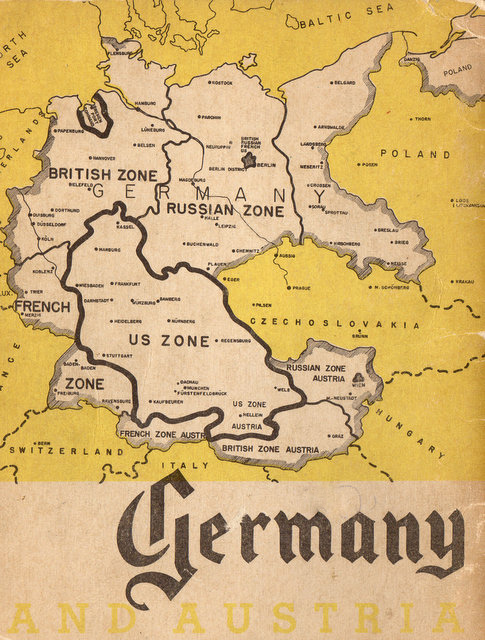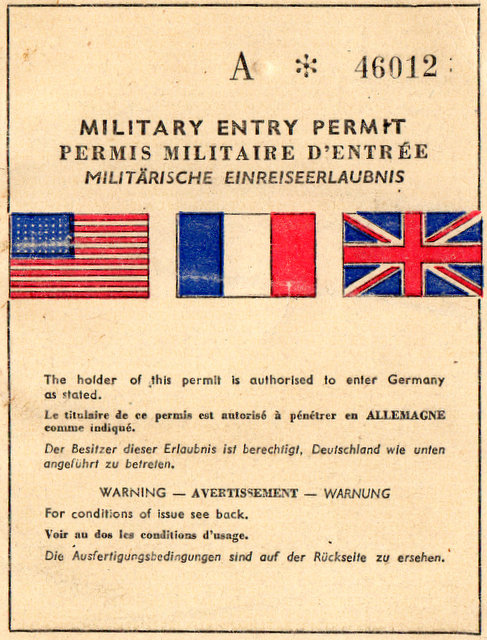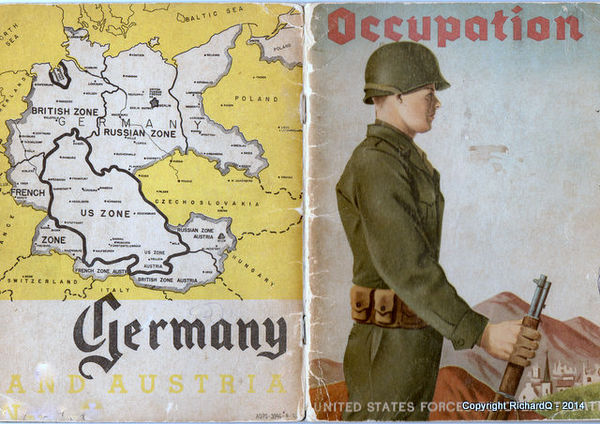How Nazi Germany was divided into Occupation Zones in 1945
Jul 7, 2014 19:37:30 #
The World War II Allies agreed, well before 1945, that the entire German nation had to be placed under strict military occupation after the Unconditional Surrender of the Nazi government. Since it was impossible to combine all the Allied armies into a single occupation force, a map was designed which divided pre-war Germany into separate military Occupation Zones -- American, British and Russian. The French were not represented in the conferences in Teheran, Iran, and Yalta, Crimean Russia, so the original plans were for three Zones. The French Zone was added only three months before Hitler's death on April 30, 1945. The American Zone was roughly 60,000 square miles, about the size of Michigan, and included Bavaria, Hesse, the northern half of Baden-Württemberg, and the southern part of Greater Berlin.
The final Occupation Zone configuration is shown below, copied from the back cover of the U.S. Army's 50-page "Occupation" orientation booklet supplied in 1945 to fresh American troops. The map also includes the Austrian Occupation Zones, although Austria never declared war on anybody, and the Allies never declared war on her. In fact, Austria was the first country the Nazis invaded, or "annexed." Their occupation did not end until 1955. Go figure.
Each Occupation Zone had a separate military administration. The four Zones were coordinated through the Allied Control Council, made up of the four supreme commanders from Britain, France, the U.S.A. and the U.S.S.R. However, each Zone commander had a relatively free hand in local areas.
In addition, the former Nazi (and Prussian) capital city of Berlin was divided into four separate Zones, each under its own army contingent with a commander. Imagine the New York City boroughs occupied by four separate armies and administered by four men, only two of whom spoke English. Occupied Berlin was an island in the middle of the Russian Zone. No official arrangement was made to guarantee unrestricted access through the Russian Zone; it was assumed there would be no problems between Allies. The Berlin Blockade of 1948 proved how wrong that assumption was.
Civilian tourism was banned in Germany for years. Only authorized military members (and their families, and Army civilian employees) were allowed to travel outside their particular Occupation Zone, provided they carried appropriate papers and did not deviate from their specified itinerary. Some Allied civilians carried special Interzonal passes (see example) which were not valid for travel in the Russian Zone.
The final Occupation Zone configuration is shown below, copied from the back cover of the U.S. Army's 50-page "Occupation" orientation booklet supplied in 1945 to fresh American troops. The map also includes the Austrian Occupation Zones, although Austria never declared war on anybody, and the Allies never declared war on her. In fact, Austria was the first country the Nazis invaded, or "annexed." Their occupation did not end until 1955. Go figure.
Each Occupation Zone had a separate military administration. The four Zones were coordinated through the Allied Control Council, made up of the four supreme commanders from Britain, France, the U.S.A. and the U.S.S.R. However, each Zone commander had a relatively free hand in local areas.
In addition, the former Nazi (and Prussian) capital city of Berlin was divided into four separate Zones, each under its own army contingent with a commander. Imagine the New York City boroughs occupied by four separate armies and administered by four men, only two of whom spoke English. Occupied Berlin was an island in the middle of the Russian Zone. No official arrangement was made to guarantee unrestricted access through the Russian Zone; it was assumed there would be no problems between Allies. The Berlin Blockade of 1948 proved how wrong that assumption was.
Civilian tourism was banned in Germany for years. Only authorized military members (and their families, and Army civilian employees) were allowed to travel outside their particular Occupation Zone, provided they carried appropriate papers and did not deviate from their specified itinerary. Some Allied civilians carried special Interzonal passes (see example) which were not valid for travel in the Russian Zone.
1945 map of Occupation Zones in Germany and Austria

Special Pass permitting entry to Occupied West Germany (but not Russian Zone)

Back and front covers of 50-page 1945 troop orientation booklet

Jul 8, 2014 08:10:26 #
Jul 8, 2014 12:57:26 #
ole sarg
Loc: south florida
Yep, the western allies got the industrial part of Germany and the Soviets got the farms!
Jul 8, 2014 13:51:13 #
ole sarg wrote:
Yep, the western allies got the industrial part of Germany and the Soviets got the farms!
Bet some of the occupation troops got to sow their wild oats
Jul 8, 2014 17:18:40 #
nikon_jon wrote:
That is a very interesting bit of history. Thanks!
Thanks for the comment, Nikon Jon. It was even more interesting to actually live it!
Jul 8, 2014 17:38:06 #
ole sarg wrote:
Yep, the western allies got the industrial part of Germany and the Soviets got the farms!
Actually, the Russians got more than just farms, Ole Sarge. One of the industries was the Carl Zeiss firm in Jena, for example. As it happens, we got to Jena first and invited the Zeiss engineers and scientists who were willing to move back with us to Western Germany before the Russians took over. With their skills and some equipment, they established the Carl Zeiss Stuttgart company which supplied us with so many fine lenses over the following years. The Russians packed up the Zeiss factory that remained and shipped it to Russia, but it soon was returned. Moscow was not impressed. However, the East Germans succeeded in turning out some very fine cameras, such as the SLR Exactas (35mm and 2-1/4). And those farms you mentioned turned into a potent weapon -- when Britain and the US decided not to let Russia into the Ruhr heavy industries, the Russians decided not to share their food production with the West. That was fine with the Western Allies, who were ordered to impose harsh conditions on the German civilians anyway. Many thousands starved in the winter of 1945-1946, when food imports were banned from the United States.
Jul 8, 2014 17:44:36 #
Shutterbugsailer wrote:
Bet some of the occupation troops got to sow their wild oats
General Eisenhower's non-fraternization order dampened some of the attraction between the frauleins and the GIs, but there still were a lot of posters on bulletin boards warning the guys to take precautions against venereal disease. The orders were watered down after a few months and disappeared by the end of 1945.
Jul 9, 2014 11:49:49 #
RichardQ wrote:
The World War II Allies agreed, well before 1945, ... (show quote)
Your posts are so very interesting, always. Have you considered writing a book and including your historical photos? I hated history when I was in school more than 50 years ago, but you make it so interesting. Thank you!!
Jul 9, 2014 21:34:01 #
ExTech2 wrote:
Your posts are so very interesting, always. Have you considered writing a book and including your historical photos? I hated history when I was in school more than 50 years ago, but you make it so interesting. Thank you!!
Thanks for the kind words, ExTech! I'm glad I haven't sunk into senility -- yet. I was assigned to Troop Information and Education in the Army Air Force, so I worked on base newspapers and occasional presentations during my service years. These little "extended captions" for my UHH posts are stirring my 87-year-old juices, but a lot of my photo material is not readily available to me. I hope to gradually assemble more of it, including the numerous photo negs for which I have no prints. I just have to replace my computer system (a 10-year-old Dell desktop) and add a negative scanner. We'll see.
If you want to reply, then register here. Registration is free and your account is created instantly, so you can post right away.


